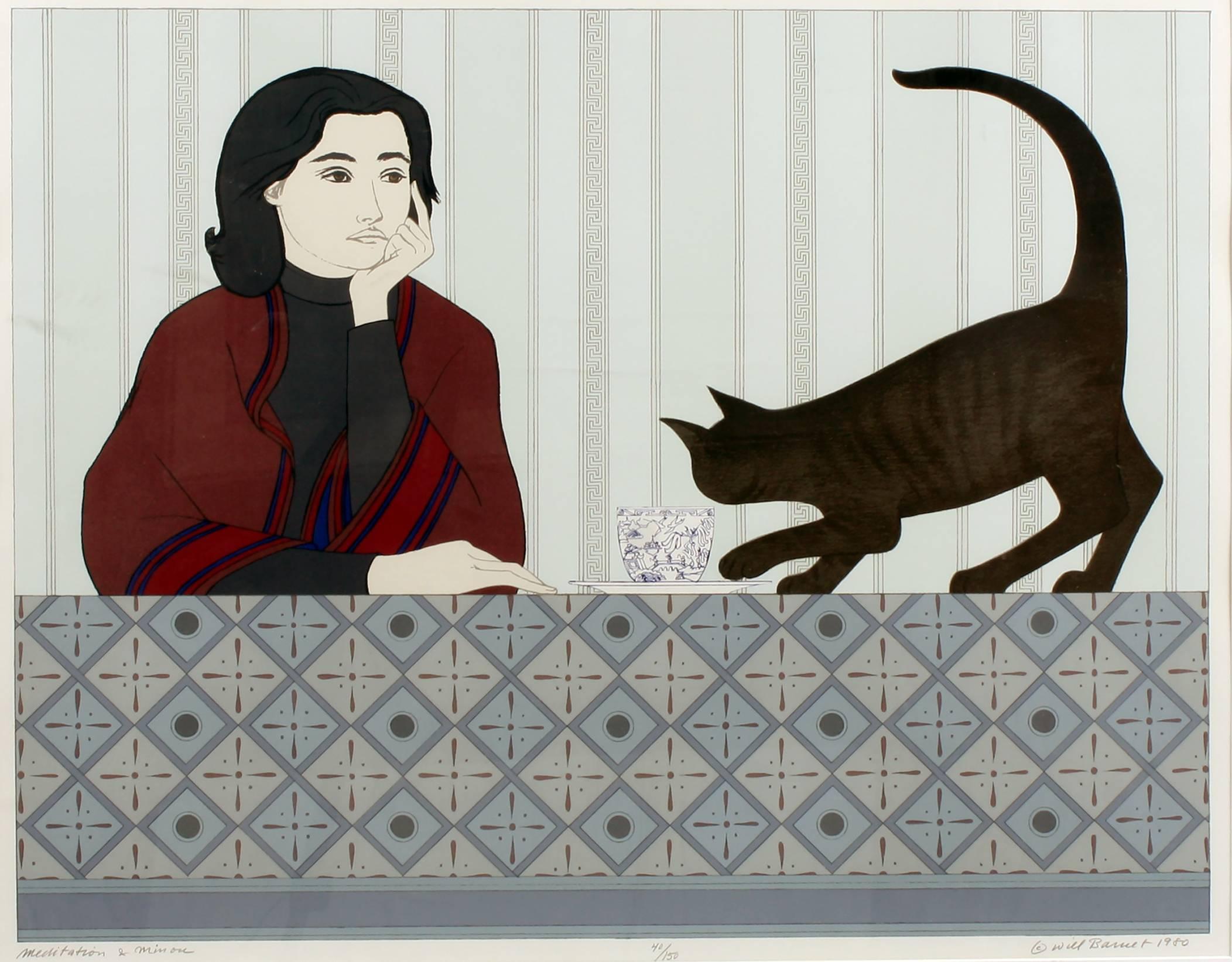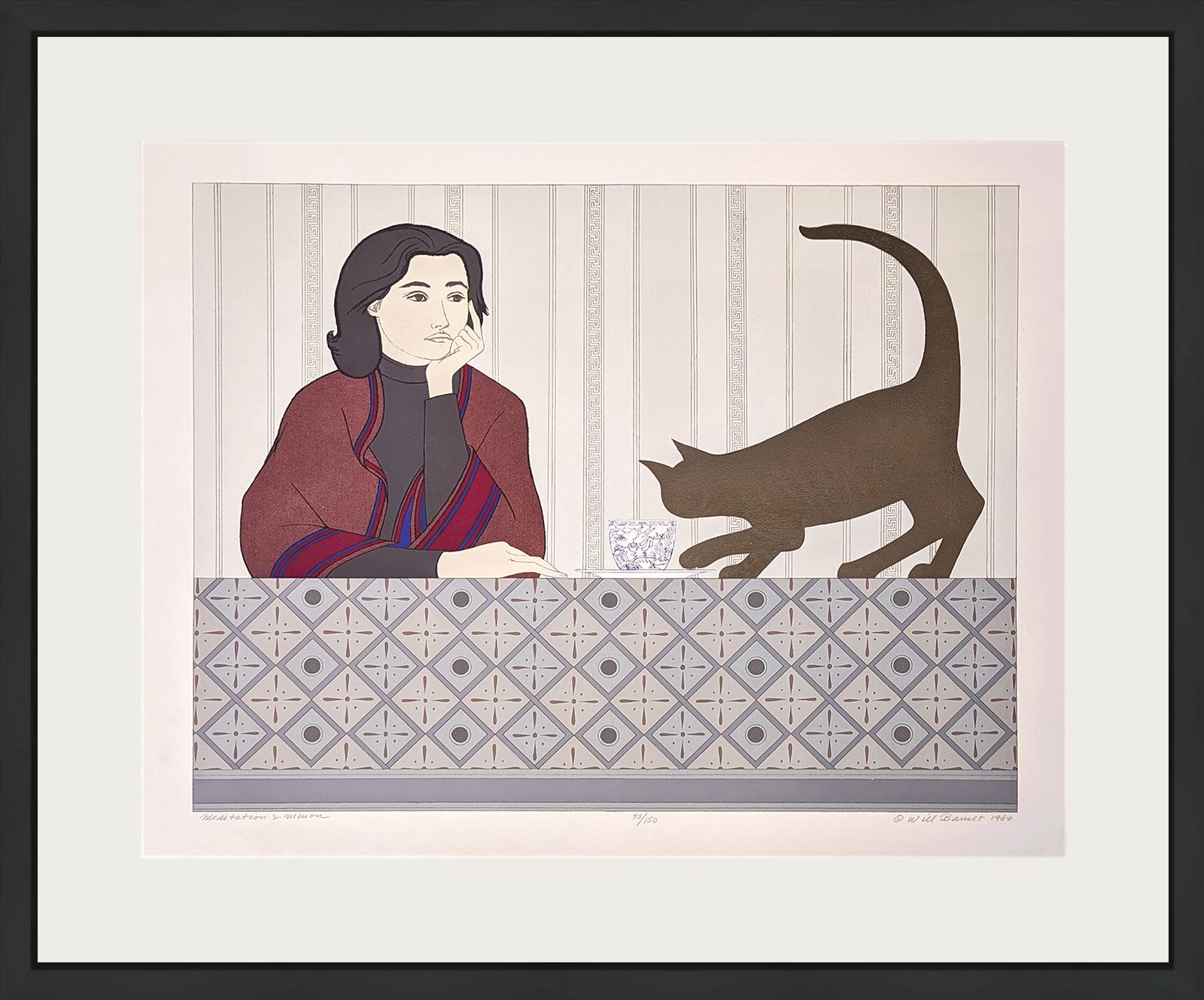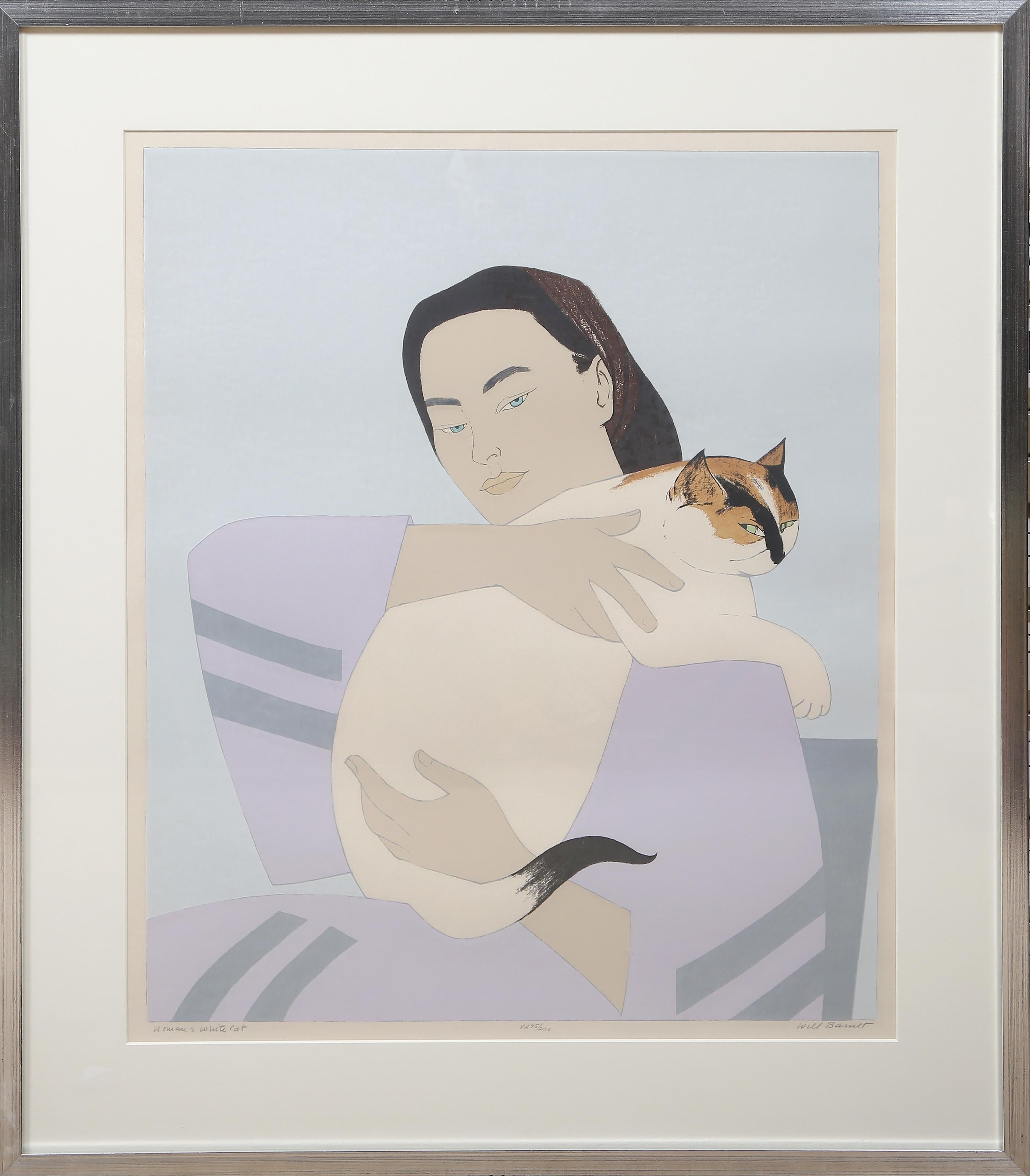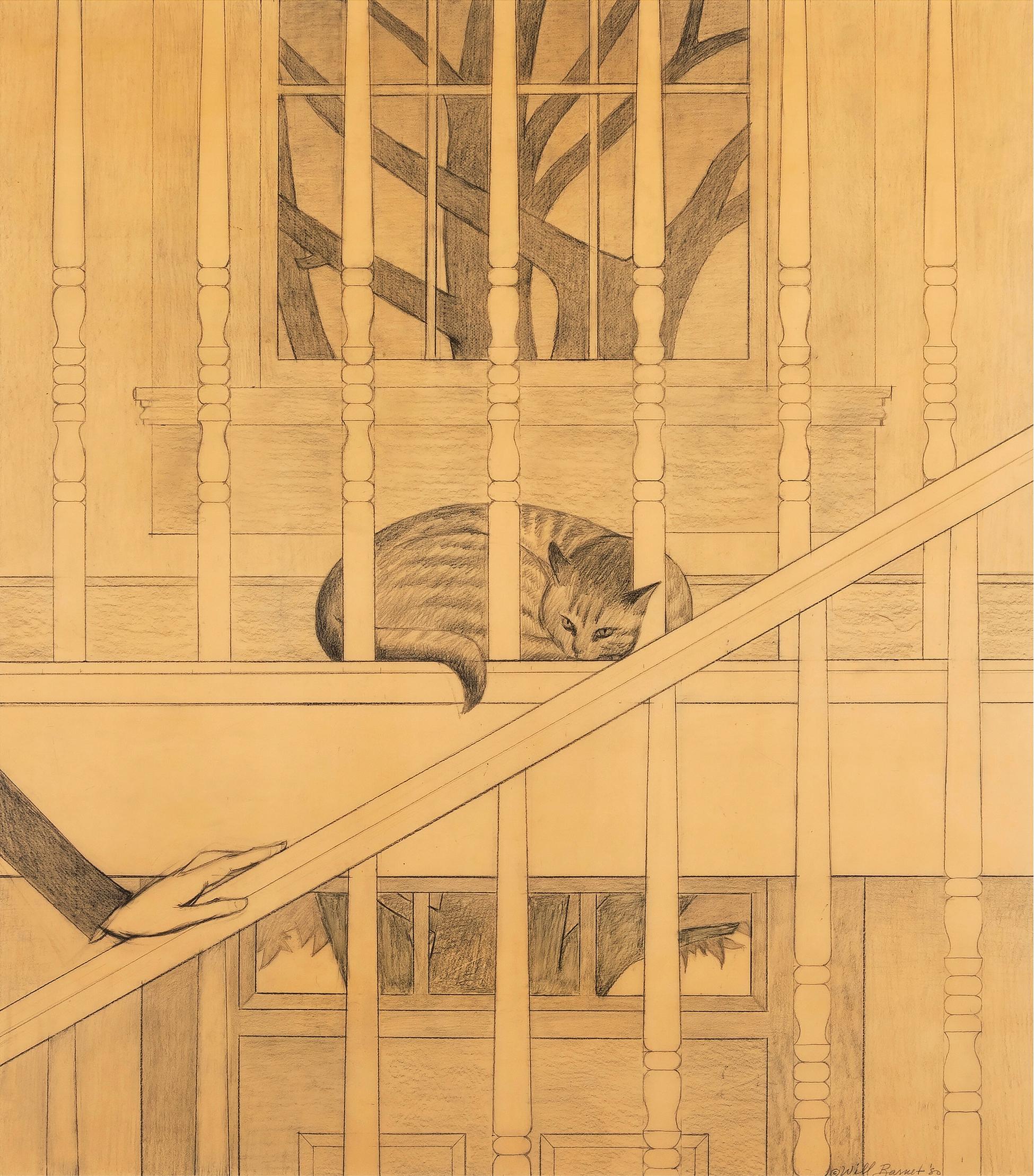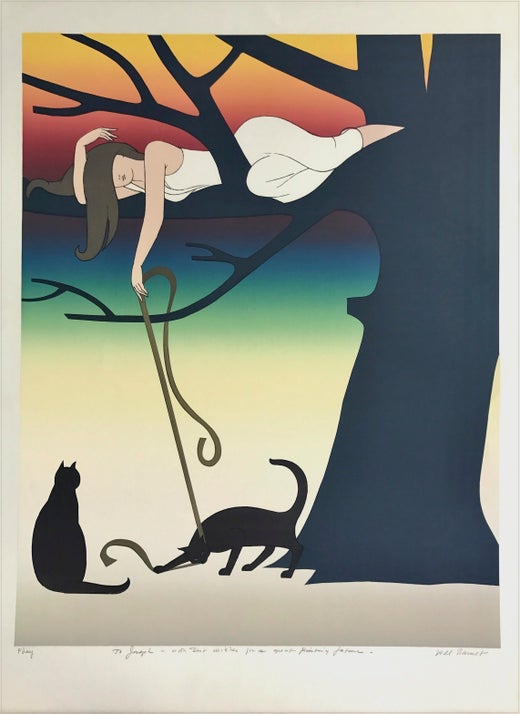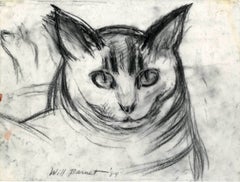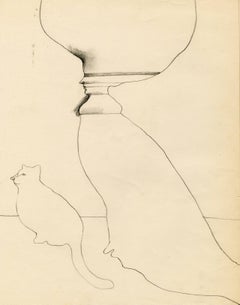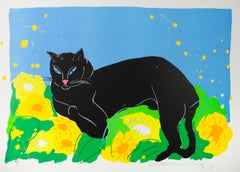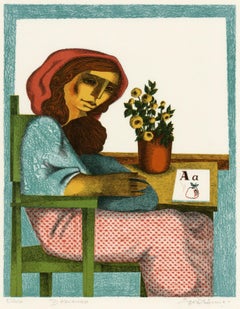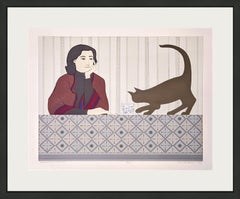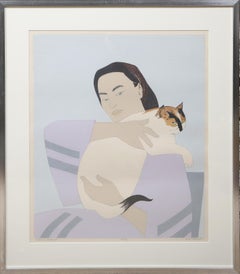Items Similar to Meditation and Minou
Want more images or videos?
Request additional images or videos from the seller
1 of 10
Will BarnetMeditation and Minou1980
1980
$2,400
£1,827.60
€2,087
CA$3,372.30
A$3,700.05
CHF 1,949.01
MX$44,016.02
NOK 24,966.58
SEK 22,797.89
DKK 15,591.90
About the Item
Meditation and Minou
Color lithograph and serigraph, 1980
Signed and numbered in pencil (see photo)
Printer Styria Studio, Inc. New York
Publisher: Harry Abrams, New York
Edition: 150 (85/150)
Reference: Szoke (Moser) 175
Condition: Printed on BFK Rives paper
Framed with glass (see photo)
- Creator:Will Barnet (1911, American)
- Creation Year:1980
- Dimensions:Height: 22 in (55.88 cm)Width: 28 in (71.12 cm)
- Medium:
- Movement & Style:
- Period:
- Condition:
- Gallery Location:Fairlawn, OH
- Reference Number:Seller: FA97191stDibs: LU14013372002
Will Barnet
At the beginning of his career, Will Barnet was known for his figural depictions of domestic scenes. But, as he continued to stylistically develop, Barnet arrived at abstract geometric paintings far removed from his original career. A part of the Indian Space Painters group, Barnet was inspired by Native American art in creating these divergent images. Throughout his career, Barnet oscillated between representational and abstract paintings, never fully settling on one. He has received the National Medal of Arts in 2011, and his work has been displayed at the Whitney Museum of American Art, the Museum of Modern Art, and the Metropolitan Museum of Art.
About the Seller
5.0
Recognized Seller
These prestigious sellers are industry leaders and represent the highest echelon for item quality and design.
Gold Seller
Premium sellers maintaining a 4.3+ rating and 24-hour response times
Established in 1978
1stDibs seller since 2013
835 sales on 1stDibs
Typical response time: <1 hour
Associations
International Fine Print Dealers Association
- ShippingRetrieving quote...Shipping from: Fairlawn, OH
- Return Policy
More From This Seller
View AllMinou-Study of Head
By Will Barnet
Located in Fairlawn, OH
Minou-Study of Head
Charcoal and pencil on vellum, 1984
Signed and dated in pencil by the artist
Minou was Barnet's feline companion throughout many of his most prolific years. It has been said that if you entered Barnet's studio and Minou did not like you Barnet lost interest and dismissed you almost immediately.
Provenance:
Susan Teller Gallery, prior to 2005 (one of Barnet's friends and dealers)
Babcock Galleries, 2005-2008
This drawing is related to a similar composition reproduced in the Richard Boyle catalog for Babcock Galleries.
References:
Boyle, Will Barnet Drawings, related to works reproduced on pp. 21, 41 (see photo of page 41)
Minou is the cat on the back right.
Condition: Excellent
Stray ink and paint consistent with a working studio drawing
Archival framing with DEN Glass (see photo)
Image size: 9 x 11 7/8 inches
Frame size: 17 x 19 inches
Will Barnet
Born May 25, 1911, Beverly, Massachusetts, US
Died November 13, 2012 (aged 101), New York City, US
Will Barnet (May 25, 1911 – November 13, 2012) was an American artist known for his paintings, watercolors, drawings, and prints depicting the human figure and animals, both in casual scenes of daily life and in transcendent dreamlike worlds.
Biography
Born in 1911 in Beverly, Massachusetts, Barnet knew by the age of ten that he wanted to be an artist. As a student, he studied with Philip Leslie Hale at the School of the Museum of Fine Arts, Boston and viewed first-hand John Singer Sargent at work on the murals of the Boston Public Library. In 1930, Barnet studied at the Art Students League of New York, with Stuart Davis and Charles Locke, beginning his long association with the school. Here he concentrated on painting as well as printmaking, and, in 1936, he became the official printer for the Art Students League. There, he later instructed students in the graphic arts at the school and taught alongside the likes of Yasuo Kuniyoshi, Robert Beverly Hale and Richard Pousette-Dart. Barnet influenced a generation of artists, including James Rosenquist, Knox Martin, Emil Milan, Paul Jenkins, Ethel Fisher and Cy Twombly. Barnet continued his love of teaching with positions at the Cooper Union, at Yale University, and at the Pennsylvania Academy of Fine Arts. He was represented by the Bertha Schaefer Gallery in New York City. Barnet had three sons, Peter, Richard, and Todd Barnet, by his first wife Mary Sinclair. Barnet later married Elena Barnet, with whom he had a daughter, Ona Barnet.
Death
A longtime resident of the National Arts Club, Barnet died in New York City on November 13, 2012, at the age of 101.
Works
Barnett's works span the various "movements" of their era, from his early social realist work to his final signature style of clean lines and carefully placed volumes of solid color in a kind of minimalist representational approach. His work is concerned with humanity, yet at his core he always remained a formalist, cerebral in his approach to the elements that make up a good picture. In his interviews he articulated his well thought out principles regarding color use, composition and subject matter, in a professorial manner reflecting the theoretical acumen he brought to his teaching. Like many American painters of his generation he was digesting the evolving trends in Europe and integrating the new visual vocabulary into his American style while remaining universal, referencing his own personal history with images of his wife, his daughter, and their family pets. As James Thomas Flexner wrote, Barnet's work "makes us experience the interplay between the personal and the universal." While remaining representational, the simple elegance of the figures and their flat surfaces reflect his exploration with abstraction.
Will's artistic output spans eighty years. Few artists, other than Picasso or Monet, can claim such a long continuous period of inspired art making, nor the logical progression of moving through artistic phases: in the 1930s he was a social realist, in the 1940s a Modernist, in the 1950s an Abstract Expressionist and in the 1960s and onward he settled on a representational minimalism honed from the refinement of his earlier explorations. His early work is decidedly social realist, with sullen portraits done in dark tonalities that suggest both the struggle of the depression era and the hope in the simple love of family life. He moves out of this phase with the improving economy and in the 1940s adds vibrant color and more abstract figures, suggesting a lifting of the depression era malaise. He was a key figure in the 1940s New York movement called Indian Space Painting, artists who based their abstract and semi-abstract work on Native American art; a striking movement which had a handful of practitioners (notably Steve Wheeler...
Category
1980s American Modern Drawings and Watercolor Paintings
Materials
Charcoal
untitled (Woman and Cat)
By Mary Spain
Located in Fairlawn, OH
Unsigned
Graphite on paper
Category
20th Century Surrealist Portrait Drawings and Watercolors
Materials
Graphite
Black Cat
By Walasse Ting
Located in Fairlawn, OH
Black Cat
Color lithograph, 1981
Signed in pencil lower right
Annotated: AP (Artist Proof)
Printer: Jorge Dumas, Atelier Dumas, New York
Condition: Very fresh colors
Slight creasing ...
Category
1980s Contemporary Figurative Prints
Materials
Lithograph
Descanso (Break)
By Jorge Dumas
Located in Fairlawn, OH
Signed, titled and numbered in pencil
Edition: 250 (5/250)
Signed, titled and numbered in pencil
Published by Circle Gallery Ltd.
Printer: Atelier Dumas, New York
Condition: Very good
Atelier Dumas opened in New York printing own work as well as
those of Peter Max, Agam, Romare Bearden, Dali, Erté, Peter Hurd,
Ting, Karl Appel...
Category
1970s Folk Art Figurative Prints
Materials
Lithograph
Jugentud (Youth)
By Jorge Dumas
Located in Fairlawn, OH
Jugentud (Youth)
Color lithograph, 1975
Signed, numbered and titled in pencil (see photos)
Edition: 250 (67/250)
Signed, titled and numbered in pencil
Published by Circle Gallery Ltd...
Category
1970s Contemporary Figurative Prints
Materials
Lithograph
A black cat and a cute little Dutch girl, from Le Chat Noir
By Théophile Alexandre Steinlen
Located in Fairlawn, OH
A black cat and a cute little Dutch girl, from Le Chat Noir
An impression of this image is in the collection of the de Young/Legion of Honor Fine Arts Museum of San Francisco
from Le...
Category
1890s Impressionist Animal Prints
Materials
Other Medium
You May Also Like
Meditation and Minou
By Will Barnet
Located in Buffalo, NY
Artist: Will Barnet, American (1911 - 2012)
Title: Meditation and Minou
Year: 1980
Medium: Lithograph and Serigraph on BFK Rives, signed and numbered in pencil
Edition: 40/150
Category
1970s American Realist Figurative Prints
Materials
Archival Paper, Lithograph
MEDITATION AND MINOU
By Will Barnet
Located in Aventura, FL
Hand signed, titled, dated and numbered by the artist. Image size 22 x 28 inches. Sheet size 28 x 34 inches. Custom framed as pictured. From the main edition of 150.
Artwork i...
Category
1980s Contemporary Portrait Prints
Materials
Lithograph
$2,765 Sale Price
30% Off
Woman and White Cat, Framed and Signed Modern Screenprint by Will Barnet
By Will Barnet
Located in Long Island City, NY
Woman and White Cat
Will Barnet, American (1911–2012)
Date: 1971
Screenprint, signed, titled and numbered in pencil
Edition of 45/200
Image Size: 23.25 x 20 inches
Size: 26 x 22 in. ...
Category
1970s American Modern Figurative Prints
Materials
Screen
Interlude, Screenprint by Will Barnet
By Will Barnet
Located in Long Island City, NY
Artist: Will Barnet, American (1911 - 2012)
Title: Interlude
Year: 1982
Medium: Serigraph, signed and numbered in pencil
Edition: AP
Image Size: 20 x 38 inches
Size: 25.5 x 42.5 in. (64.77 x 107.95 cm)
Fig 179, pg 70 from Will Barnet: Prints 1931-2005, published by John Szoke...
Category
1980s American Modern Figurative Prints
Materials
Screen
The Cat, Signed Modern Screenprint by Will Barnet
By Will Barnet
Located in Long Island City, NY
Artist: Will Barnet, American (1911 - 2012)
Title: The Cat
Year: 1997
Medium: Screenprint on Arches, signed in pencil
Edition: AP
Image Size: 16 x 7 inches
Siz...
Category
1990s American Modern Figurative Prints
Materials
Screen
Cat Nap - Study for "Anticipation"
By Will Barnet
Located in Miami, FL
Cat Nap on the steps captured by realist painter Will Barnet. This is more than just a preliminary study; it's polished and precise, which allows it to stand on its own. In person, i...
Category
1980s American Realist Portrait Drawings and Watercolors
Materials
Paper, Pencil
